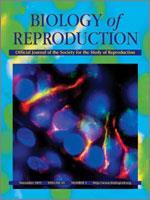Uterine gland formation occurs postnatally in an ovary- and steroid-independent manner in many species, including humans. Uterine glands secrete substances that are essential for embryo survival. Disruption of gland development during the postnatal period prevents gland formation, resulting in infertility. Interestingly, stabilization of beta-catenin (CTNNB1) in the uterine stroma causes a delay in gland formation rather than a complete absence of uterine glands. Thus, to determine if a critical postnatal window for gland development exists in mice, we tested the effects of extending the endocrine environment of pregnancy on uterine gland formation by treating neonatal mice with estradiol, progesterone, or oil for 5 days. One uterine horn was removed before puberty, and the other was collected at maturity. Some mice were also ovariectomized before puberty. The hormone-treated mice exhibited a delay in uterine gland formation. Hormone-treatment increased the abundance of uterine CTNNB1 and estrogen receptor alpha (ESR1) before puberty, indicating possible mechanisms for delayed gland formation. Despite having fewer glands, progesterone-treated mice were fertile, suggesting that a threshold number of glands is required for pregnancy. Mice that were ovariectomized before puberty did not undergo further uterine growth or gland development. Finally, to establish the role of the ovary in postpartum uterine gland regeneration, mice were either ovariectomized or given a sham surgery after parturition, and uteri were evaluated 1 wk later. We found that the ovary is not required for uterine growth or gland development following parturition. Thus, uterine gland development occurs continuously in mice and requires the ovary after puberty, but not after parturition.
How to translate text using browser tools
6 July 2011
Uterine Gland Formation in Mice Is a Continuous Process, Requiring the Ovary after Puberty, But Not after Parturition
C. Allison Stewart,
Sara J. Fisher,
Ying Wang,
M. David Stewart,
Sylvia C. Hewitt,
Karina F. Rodriguez,
Kenneth S. Korach,
Richard R. Behringer
ACCESS THE FULL ARTICLE

Biology of Reproduction
Vol. 85 • No. 5
November 2011
Vol. 85 • No. 5
November 2011
Endometrium
female reproductive tract
uterine gland
uterus




